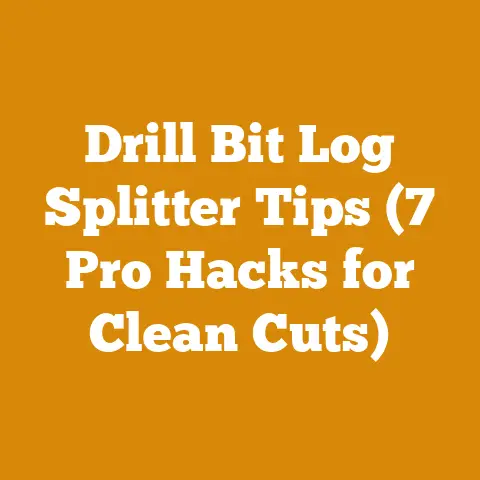Should I Put Sugar in Christmas Tree Water? (5 Pro Arborist Tips)
Should I Put Sugar in Christmas Tree Water? (5 Pro Arborist Tips)
Let’s talk Christmas trees! As someone who’s spent a lifetime felling trees in the Pacific Northwest and milling lumber, I’ve seen firsthand what makes a tree thrive, and what sends it to an early demise. And believe me, I’ve heard all the old wives’ tales about keeping Christmas trees fresh, sugar in the water being one of the most persistent. So, let’s dive into whether sugar actually helps your Christmas tree, and I’ll share some pro arborist tips I’ve learned along the way.
The Sugar Myth: Does It Really Work?
The idea behind adding sugar to your Christmas tree water is that it provides the tree with a source of energy, mimicking the sugars it would normally produce through photosynthesis. It sounds logical, right? But here’s the rub: trees don’t really “drink” water for energy in the way we think. They primarily use water to transport nutrients and maintain cell turgor pressure – basically, keeping their cells plump and hydrated.
Adding sugar to the water can actually promote microbial growth. This sugary water becomes a breeding ground for bacteria and mold, which can clog the tree’s vascular system (the xylem), hindering its ability to absorb water. Think of it like plaque buildup in your arteries. Not good!
Pro Arborist Tip #1: Fresh Cut is Key
The most crucial step in keeping your Christmas tree fresh is making a fresh cut at the base of the trunk. When a tree is cut, sap quickly seals the cut end, preventing water uptake. I always tell folks, imagine a scab forming on a wound; it needs to be reopened to heal properly.
Here’s what you need to do:
- Timing is everything: Make the fresh cut immediately before placing the tree in its stand.
- Measure twice, cut once: Remove at least 1/2 inch, but no more than 2 inches, of the trunk using a pruning saw or small handsaw.
- Straight cut: Make a straight cut, not an angled one. An angled cut reduces the surface area available for water absorption.
- Get it in water ASAP: Place the tree in water within 8 hours of cutting to prevent the cut end from sealing again.
This fresh cut is your tree’s lifeline. Don’t skip it!
Pro Arborist Tip #2: Water is Your Best Friend (No Additives Needed)
Plain, clean water is the best thing you can give your Christmas tree. Forget the sugar, aspirin, bleach, or any other concoction you might have heard about. These additives are either ineffective or potentially harmful.
Here’s how to keep your tree properly hydrated:
- Use a large stand: Choose a stand that can hold at least one gallon of water. Trees can drink a surprising amount, especially in the first few days.
- Check the water level daily: A freshly cut tree can drink a gallon of water per day. Make sure the water level never drops below the cut end of the trunk. If it does, the tree will start to seal again.
- Top it off: Use tap water. No need for distilled or fancy water.
Think of it this way: you wouldn’t add sugar to your drinking water all day, every day. Your tree doesn’t need it either.
Pro Arborist Tip #3: Location, Location, Location
Where you place your Christmas tree can significantly impact its lifespan. Avoid placing it near heat sources such as fireplaces, radiators, or direct sunlight. These heat sources will dry out the tree quickly, causing it to lose its needles and become a fire hazard.
Here’s what to consider:
- Cool is king: Choose a location that is away from direct heat sources and receives good air circulation.
- Humidity helps: If your home is particularly dry, consider using a humidifier near the tree to help maintain moisture levels.
- Strategic placement: Place the tree in a spot where it won’t be bumped or jostled frequently. This will help prevent needle drop.
I once had a customer who put their tree right next to a wood-burning stove. It was a beautiful tree, but it dried out in less than a week! Learn from their mistake.
Pro Arborist Tip #4: Needle Check and Hydration Indicators
Pay attention to your tree! It will tell you if it’s not getting enough water. The best way to gauge your tree’s health is by checking its needles.
Here’s what to look for:
- Needle texture: Healthy needles should be pliable and green. If they are brittle, dry, and easily fall off, your tree is dehydrated.
- Needle color: Browning needles are a sign of dehydration. Pay particular attention to the needles closest to the trunk.
- Branch flexibility: Healthy branches should be flexible and bend slightly when you touch them. Brittle branches are a sign of dehydration.
If you notice any of these signs, immediately check the water level in the stand and ensure the cut end of the trunk is submerged. You might also consider giving the tree a good misting with water.
Pro Arborist Tip #5: Choosing the Right Tree in the First Place
The best way to ensure a long-lasting Christmas tree is to choose a healthy one from the start. Here’s what to look for when selecting your tree:
- Freshness test: Gently grasp a branch about six inches from the tip and pull it towards you. Very few needles should come off. If a shower of needles falls, the tree is likely dry and not fresh.
- Needle color: Look for a tree with vibrant green needles. Avoid trees with yellowing or browning needles.
- Trunk straightness: Choose a tree with a straight trunk. This will make it easier to secure in the stand.
- Smell: A fresh tree should have a fragrant aroma. If it doesn’t smell like anything, it may not be very fresh.
- Source matters: Buy from reputable Christmas tree farms or retailers. These businesses typically take better care of their trees and ensure they are freshly cut.
Back in my logging days, we always joked that a good tree smells like Christmas and feels like a good investment. Choose wisely!
Beyond the Basics: Understanding Tree Physiology
To truly understand why sugar is a myth, it helps to know a bit about how trees work. Trees transport water and nutrients through a vascular system called the xylem. The xylem consists of tiny tubes that run from the roots to the needles. Water is drawn up through the xylem by a process called transpiration, where water evaporates from the needles, creating a negative pressure that pulls water up from the roots.
When a tree is cut, this system is disrupted. The cut end of the trunk begins to seal with sap, preventing water uptake. This is why the fresh cut is so important. It reopens the xylem and allows the tree to continue absorbing water.
Adding sugar to the water disrupts this process in a few ways:
- Microbial growth: As mentioned earlier, sugar promotes the growth of bacteria and mold, which can clog the xylem.
- Osmotic imbalance: High concentrations of sugar can disrupt the osmotic balance within the tree’s cells, potentially drawing water out of the cells instead of into them.
- No real benefit: Trees primarily need water for hydration and nutrient transport, not for energy. They don’t “eat” sugar through their trunks.
The Science of Hydration: A Deeper Dive
Let’s delve a bit deeper into the science of hydration. The key to keeping your Christmas tree fresh is maintaining its turgor pressure. Turgor pressure is the pressure exerted by the water inside the plant cells against the cell wall. This pressure is what keeps the cells firm and the needles plump.
When a tree is dehydrated, turgor pressure decreases, causing the cells to shrink and the needles to become brittle and dry. By providing the tree with a constant supply of fresh water, you can maintain turgor pressure and keep the needles hydrated.
Here’s a little experiment you can try: Take two sprigs of evergreen needles. Place one in a glass of plain water and leave the other one out in the open air. Observe them over the next few days. You’ll notice that the sprig in the water stays green and pliable, while the one in the air dries out and turns brown. This simple experiment demonstrates the importance of hydration.
Common Mistakes and How to Avoid Them
Even with the best intentions, people often make mistakes when caring for their Christmas trees. Here are some common pitfalls and how to avoid them:
- Letting the water level drop: This is the most common mistake. Check the water level daily and refill as needed.
- Using a small stand: A small stand won’t hold enough water to keep the tree properly hydrated. Choose a stand that can hold at least one gallon of water.
- Not making a fresh cut: If you skip the fresh cut, the tree won’t be able to absorb water effectively.
- Placing the tree near heat: Heat sources will dry out the tree quickly.
- Using additives in the water: Stick to plain water. Additives are unnecessary and can even be harmful.
- Ignoring the signs of dehydration: Pay attention to the needles and branches. If they are dry, brittle, or browning, take action immediately.
I’ve seen folks get so caught up in the holiday hustle that they forget to water their tree. Don’t let that be you!
The Environmental Impact of Christmas Trees
Choosing a real Christmas tree can actually be a more environmentally friendly option than using an artificial tree. Real trees are a renewable resource, and Christmas tree farms provide important habitat for wildlife.
Here are some environmental benefits of real Christmas trees:
- Renewable resource: Christmas trees are grown on farms specifically for the purpose of being harvested.
- Carbon sequestration: Growing Christmas trees helps to absorb carbon dioxide from the atmosphere.
- Habitat for wildlife: Christmas tree farms provide habitat for birds, mammals, and other wildlife.
- Biodegradable: After the holidays, real Christmas trees can be recycled or composted.
Artificial trees, on the other hand, are typically made from non-renewable materials such as plastic and metal. They also require energy to manufacture and transport, and they are not biodegradable.
When you’re done with your tree, consider recycling it. Many communities offer Christmas tree recycling programs. You can also chip the tree yourself and use the mulch in your garden.
Alternative Hydration Methods: Misting and Anti-Transpirants
While keeping the tree’s base submerged in water is the most important hydration method, there are a couple of additional things you can do to help keep your tree fresh:
- Misting: Regularly misting the tree with water can help to increase humidity and keep the needles hydrated. Use a spray bottle to mist the tree every day or two.
- Anti-transpirants: Anti-transpirants are products that can be sprayed on the needles to reduce water loss. These products work by forming a thin, waxy coating on the needles, which helps to prevent water from evaporating. Follow the instructions on the product label carefully.
I’ve used misting systems on large displays, and they can make a noticeable difference, especially in dry climates.
Choosing the Right Species for Longevity
The species of Christmas tree you choose can also affect its longevity. Some species are naturally more resistant to drying out than others.
Here are some of the most popular Christmas tree species and their characteristics:
- Douglas Fir: This is one of the most popular Christmas tree species. It has soft, fragrant needles and good needle retention.
- Noble Fir: Noble firs have strong branches and excellent needle retention. They are a good choice for heavy ornaments.
- Fraser Fir: Fraser firs have a pleasant fragrance and good needle retention. They are also relatively resistant to drying out.
- Scotch Pine: Scotch pines have long, stiff needles and excellent needle retention. They are a good choice for people with allergies.
- White Pine: White pines have soft, blue-green needles and a mild fragrance. They are less prone to needle drop than some other species.
When choosing a Christmas tree, consider the species and its characteristics. If you live in a dry climate, choose a species that is known for its good needle retention.
Safety First: Fire Prevention Tips
A dry Christmas tree is a fire hazard. Take these precautions to minimize the risk of fire:
- Keep the tree watered: A well-hydrated tree is less likely to catch fire.
- Inspect lights: Check your Christmas lights for frayed wires or broken bulbs. Replace any damaged lights.
- Use LED lights: LED lights generate less heat than traditional incandescent lights.
- Don’t overload outlets: Avoid overloading electrical outlets with too many lights or decorations.
- Never leave lights unattended: Turn off Christmas lights when you leave the house or go to bed.
- Keep flammable materials away: Keep flammable materials such as wrapping paper and decorations away from the tree.
- Have a fire extinguisher nearby: Make sure you have a working fire extinguisher nearby and that you know how to use it.
I’ve seen firsthand the devastation a Christmas tree fire can cause. Don’t take chances.
Dealing with Needle Drop: Cleanup Strategies
Even with the best care, some needle drop is inevitable. Here are some tips for dealing with needle drop:
- Use a tree bag: Place a tree bag under the tree to catch falling needles.
- Vacuum regularly: Vacuum the area around the tree regularly to remove fallen needles.
- Use a needle grabber: A needle grabber is a tool that can be used to pick up fallen needles from carpets and floors.
- Sweep hard surfaces: Sweep hard surfaces such as hardwood floors and tile to remove fallen needles.
A little planning can make cleanup much easier.
Extending the Life of Your Tree: Post-Holiday Options
Once the holidays are over, there are several things you can do with your Christmas tree:
- Recycle it: Many communities offer Christmas tree recycling programs.
- Compost it: You can compost your Christmas tree in your backyard compost pile.
- Use it for mulch: Chip the tree yourself and use the mulch in your garden.
- Create a wildlife habitat: Place the tree in your backyard to provide shelter for birds and other wildlife.
Don’t just throw your tree in the trash. Give it a second life!
The Final Verdict: Skip the Sugar, Embrace the Water
So, should you put sugar in your Christmas tree water? The answer is a resounding no. Plain, clean water is the best thing you can give your tree. Focus on making a fresh cut, keeping the water level high, choosing the right location, monitoring the tree’s health, and selecting a fresh tree from the start.
Follow these pro arborist tips, and you’ll be able to enjoy a beautiful, long-lasting Christmas tree throughout the holiday season. Happy holidays, and may your tree stay green and bright!
Actionable Steps for a Healthy Christmas Tree:
- Fresh Cut: Immediately before placing your tree, make a fresh, straight cut removing 1/2 to 2 inches from the base.
- Water, Water, Water: Use a stand that holds at least one gallon of water and check the water level daily, ensuring the base is always submerged.
- Strategic Placement: Position your tree away from heat sources like fireplaces, radiators, and direct sunlight.
- Regular Monitoring: Check the needles and branches regularly for signs of dryness or browning.
- Choose Wisely: Select a fresh, healthy tree from a reputable source, testing its needle retention before purchasing.
- Skip Additives: Avoid adding sugar, aspirin, or other additives to the water. Plain water is best.
- Misting (Optional): In dry climates, consider misting the tree with water daily to increase humidity.
- Safety First: Inspect lights for damage and use LED lights to reduce heat. Never leave lights unattended.
- Plan for Cleanup: Use a tree bag or vacuum regularly to manage needle drop.
- Recycle After Holidays: Recycle or compost your tree after the holidays to minimize environmental impact.






